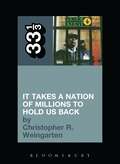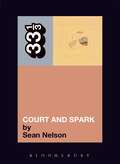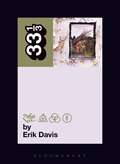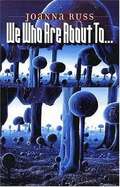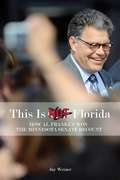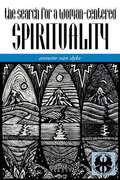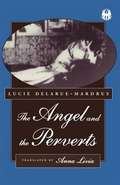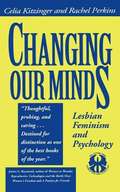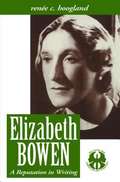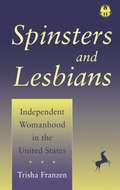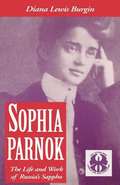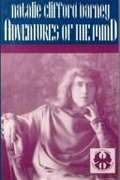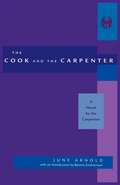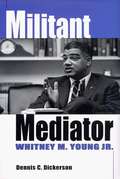- Table View
- List View
Heroes and Orators
by Robert PhelpsAgainst the background of studied urbanity in an art colony in the Catskills is developed the progression into emotional bankruptcy of three lives, recorded by Roger Becket, a watcher, involved beyond his willingness. After Mark's death, his twenty-year-old wife, Elizabeth, leaves the Pennsylvania university town where her husband taught, to live in Highkill with Margot, Mark's first wife, a commercial artist. Elizabeth is a beautiful, willful, intriguing creature, fascinated by her own perversities and fascinating to Margot who loves her but is ashamed of her feelings, to Roger who, unsure of his own role and responsibilities is afraid of her, and to Gib, who sees her as another in a long line of bedfellows. Mark's death has been for Roger the beginning of his self-realization through the relationships which it thrust upon him.
Public Enemy's It Takes a Nation of Millions to Hold Us Back (33 1/3 Ser. #71)
by Christopher R. WeingartenChristopher R. Weingarten provides a thrilling account of how the Bomb Squad produced such a singular-sounding record: engineering, sampling, scratching, constructing, deconstructing, reconstructing—even occasionally stomping on vinyl that sounded too clean. Using production techniques that have never been duplicated, the Bomb Squad plundered and reconfigured their own compositions to make frenetic splatter collages; they played samples by hand together in a room like a rock band to create a “not quite right” tension; they hand-picked their samples from only the ugliest squawks and sirens.
Fleetwood Mac's Tusk (33 1/3 Ser. #77)
by Rob TrucksAfter Rumours became the best-selling single album of all-time, Fleetwood Mac asked Warner Brothers Records to buy them a studio (the label refused, costing both Warner Brothers and the band significant cash in the long run) and then handed the reins to their guitarist and resident perfectionist Lindsey Buckingham, a fusion of factors that led Tusk to become the first record in history to cross the million dollar threshold in production costs. “You know,” Buckingham told me, “we had this ridiculous success with Rumours. And at some point, at least in my perception, the success of that detached from the music, and it was more about the phenomenon. We were poised to do another album, and I guess because the axiom 'If it works, run it into the ground’ was prevalent then, we were probably poised to do Rumours II. I don’t know how you do that, but somehow my light bulb that went off was, ‘Let’s just not do that. Let’s very pointedly not do that.’” Here, Rob Trucks talks to Lindsey Buckingham, as well as members of Animal Collective, Camper Van Beethoven, the New Pornographers, Wolf Parade, the Fleetwood Mac tribute band. Tusk, and the USC Trojan marching band in order to chart both the story and the impact of an album born of personal obsession and a stubborn unwillingness to compromise.
Joni Mitchell's Court and Spark (33 1/3 Ser. #40)
by Sean NelsonIt’s a sucker bet to try and argue that Blue, or For 2 the Roses, or The Hissing of Summer Lawns are better or worse albums than Court and Spark, or than one another. In a certain way, they all feel like one sustained burst of musical endeavor from an artist who had only just begun to understand what she was capable of—and before she had decided to leave that strength behind in search of new powers. Still, Court and Spark is such a clear turning point, not just in terms of its popularity, but in terms of its approach. It represents a perfect example of an artist reaching out to a wide audience without pandering to it, in what feels, more than three decades on, like an honest attempt to say as much as possible to as many people as possible.
Led Zeppelin's Led Zeppelin IV (33 1/3 #17)
by Erik DavisStripping their famous name off the record was Led Zeppelin’s almost petulant attempt to let their Great Work stand on its own two feet. But the wordless jacket also lent the album charisma. Fans hunted for hidden meanings, or, in failing to find them, sensed a strange reflection of their own mute refusal to communicate with the outside world. This helped to create one of the supreme paradoxes of rock history: an esoteric megahit, a blockbuster arcanum....
Sign 'O' the Times (33 1/3 #10)
by Michaelangelo MatosOne of the greatest double albums of the vinyl era, Sign 'O' the Times shows Prince at his peak. Here, Michaelangelo Matos tells the story of how it emerged from an extraordinary period of creativity to become one of the landmark recordings of the 1980s. He also illustrates beautifully how - if a record is great enough and lucky enough to hit you at the right time - it can change your way of looking at the world.
We Who Are About To...
by Joanna Russ Samuel R. DelanyFirst published in 1976. A multi-dimensional explosion hurls the starship's few passengers across the galaxies and onto an uncharted barren tundra. With no technical skills and scant supplies, the survivors face a bleak end in an alien world. One brave woman holds the daring answer, but it is the most desperate one possible. Elegant and electric, We Who Are About To... brings us face to face with our basic assumptions about our will to live. While most of the stranded tourists decide to defy the odds and insist on colonizing the planet and creating life, the narrator decides to practice the art of dying. When she is threatened with compulsory reproduction, she defends herself with lethal force. Originally published in 1977, this is one of the most subtle, complex, and exciting science fiction novels ever written about the attempt to survive a hostile alien environment. It is characteristic of Russ's genius that such a readable novel is also one of her most intellectually intricate.
This Is Not Florida: How Al Franken Won the Minnesota Senate Recount
by Jay WeinerOn July 7, 2009, Al Franken was sworn in as Minnesota's junior U.S. senator, eight months after Election Night. In the chill of November 2008, Republican incumbent Norm Coleman led by a slim 215 votes, a margin that triggered an automatic statewide recount of more than 2.9 million ballots. Minnesota's ensuing recount, and the contentious legal and public relations battle that would play out between the Franken and Coleman lawyers and staff, simultaneously fascinated and frustrated Minnesotans and the nation-all while a filibuster-proof Senate hung in the balance. This Is Not Florida is the behind-the-scenes saga of the largest, longest, and most expensive election recount in American history. Reporter Jay Weiner covered the entire recount process-for which he was honored with Minnesota's most prestigious journalism award-following every bizarre twist and turn and its many colorful personalities. Based on daily reporting as well as interviews with more than forty campaign staffers and other participants in the recount, This Is Not Florida dives into the motivations of key players in the drama, including the exploits of Franken's lead attorney Marc Elias, some of the mistakes made by Coleman advisers, and how the Franken team's devotion to data collection helped Franken win the recount by a mere 312 votes. In a fascinating, blow-by-blow account of the historic recount that captivated people nationwide, Jay Weiner gets inside campaign war rooms and judges' chambers and takes the reader from the uncertainties of Election Night 2008, through the controversial State Canvassing Board and a grueling eight-week trial, to an appeal to Minnesota's Supreme Court, and finally to Al Franken's long-awaited and emotional swearing-in. This Is Not Florida presents an important and unforgettable moment in political history that proved that it's never really over until it's actually over.
Lou Grant: The Making of TV's Top Newspaper Drama (Television and Popular Culture Ser.)
by Douglass K. DanielAn account of the TV program Lou Grant. The creation of characters, casting of actors, the script writing process and the impact of network censors are detailed here. Interviews with actors, producers, writers, directors are also incorporated. It summarizes all 114 episodes, discusses original character sketches, and includes editorial cartoons of the critical acclaimed TV drama. The book also describes the bitter controversy that erupted in 1982 when lead actor Edward Asner came under fire for his political beliefs regarding American involvement in El Salvador.
The Search for a Woman-Centered Spirituality
by Annette Van DykeThis work focuses on one of the salient developments of contemporary feminism. Instead of abandoning religious practice altogether as relics of a patriarchal past, large numbers of women have sought to incorporate healing and positive aspects of their spiritual heritage into their lives. Women have also resurrected non-Western traditions and have created alternative rituals, beliefs, and stories to enhance and enlighten our day-to-day existence. This work is a tribute to that creative energy and to the way in which it has enriched feminism for many. The book analyzes themes in several books exemplifying woman-centered spirituality.
Lesbian Friendships (Cutting Edge)
by Jacqueline S. Weinstock Esther RothblumFriends as lovers; lovers as friends; ex-lovers as friends; ex-lovers as family; friends as family; communities of friends; lesbian community. These are just a few of the phrases heard often in the daily discourse of lesbian life. What significance do they have for lesbians? Do lesbians view friends as family and what does this analogy mean? What sorts of friendships exist between lesbians? What sorts of friendships do lesbians form with non-lesbian women, or with men? These and other questions regarding the kinds of friendships lesbians imagine and experience have rarely been addressed. Lesbian Friendships focuses on actual accounts of friendships involving lesbians and examines a number of issues, including the transition from friends to lovers and/or lovers to friends, erotic attraction in friendship, diverse identities among lesbians, and friendships across sexuality and/or gender lines.
(Sem)Erotics: Writing
by Elizabeth MeeseWhat is at stake in the production of experimental texts by lesbian writers? what motivates these writers and characterizes their work? In this work, Elizabeth Meese examines the ways in which the experiences of the text, and the experiences of character, diverge and converge wit the writer's own biography.
The Angel and the Perverts
by Lucie Delarue-Mardrus Anna LiviaFirst published in 1930. Set in the lesbian and gay circles of Paris in the 1920s, The Angel and the Perverts tells the story of a hermaphrodite born to upper class parents in Normandy and ignorant of his/her physical difference. As an adult, s/he lives a double life as Marion/Mario, passing undetected as a lesbian in the literary salons of the times, and as a gay man in the cocaine dens made famous by Colette.
Changing Our Minds: Lesbian Feminism and Psychology
by Celia Kitzinger Rachel PerkinsWomen today are being instructed on how they can raise their self-esteem, love their inner child, survive their toxic families, overcome codependency, and experience a revolution from within. By holding up the ideal of a pure and happy inner core, psychotherapists refuse to acknowledge that a certain degree of unhappiness or dissatisfaction is a routine part of life and not necessarily a cause for therapy. Lesbians specifically are now guided to define themselves according to their frailties, inadequacies, and insecurities. An incisive critique of contemporary feminist psychology and therapy, Changing our Minds argues not just that the current practice of psychology is flawed, but that the whole idea of psychology runs counter to many tenets of lesbian feminist politics. Recognizing that many lesbians do feel unhappy and experience a range of problems that detract from their well-being, Changing Our Minds makes positive, prescriptive suggestions for non-psychological ways of understanding and dealing with emotional distress. Written in a lively and engaging style, Changing our Minds is required reading for anyone who has ever been in therapy or is close to someone who has, and for lesbians, feminists, psychologists, psychotherapists, students of psychology and women's studies, and anyone with an interest in the development of lesbian feminist theory, ethics, and practice.
Elizabeth Bowen: A Reputation in Writing
by Renee C. HooglandImmensely popular during her lifetime, the Anglo-Irish writer Elizabeth Bowen (1899-1973) has since been treated as a peripheral figure on the literary map. If only in view of her prolific output--ten novels, nearly eighty short stories, and a substantial body of non- fiction--Bowen is a noteworthy novelist. The radical quality of her work, however, renders her an exceptional one. Surfacing in both subject matter and style, her fictions harbor a subversive potential which has hitherto gone unnoticed. Using a wide range of critical theories-from semiotics to psychoanalysis, from narratology to deconstruction-this book presents a radical re-reading of a selection of Bowen's novels from a lesbian feminist perspective. Taking into account both cultural contexts and the author's non-fictional writings, the book's main focus is on configurations of gender and sexuality. Bowen's fiction constitutes an exploration of the unstable and destabilizing effects of sexuality in the interdependent processes of subjectivity and what she herself referred to as so-called reality.
Paint It Today
by Hilda Doolittle Cassandra LaityThis novel, a never before published Roman a clef by the famous imagist writer, H.D. (Hilda Doolittle), that explores H.D.'s love for women, is a lyrical recreation of the love and loss of her friend and first love, Frances Gregg, and of her later meeting with Bryher who was to become H.D.'s lifelong companion. Spanning the years from H.D.'s childhood in Pennsylvania to the birth of her daughter, Perdita, in 1919, this turbulent love story is set against the backdrop of World War I, H.D.'s involvement in early 20th century London literary circles, her brief engagement to American poet, Ezra Pound, and her shattered marriage to British novelist Richard Aldington. Paint it Today is H.D.'s most lesbian novel, a modern, homoerotic tale of passage which focuses almost entirely on the young heroine's search for the sister love which would empower her spiritually, creatively, and sexually. Cassandra Laity's introduction places H.D.'s love for the sexually magnetic, betraying Gregg and for the more nurturing and loyal Bryher in the context of the lesbian romanticism of early modern fiction. Her annotations of all Greek references and literary quotations, as well as biographical facts represented in the text, provide nuance and detail to this engrossing work.
Your John: The Love Letters of Radclyffe Hall
by Radclyffe Hall Joanne GlasgowA collection of love letters written by Hall to Evguenia Souline from 1934 to 1942 offering insights into the artistic and political ideas of the 20th century's most famous lesbian novelist. The letters convey the obsessional love and betrayal of which good drama is made and which editor Glasgow argues was the cause of Hall's creative decline. Additionally, the letters supply important critical information about the author's views on her novel (banned in 1928 by the British government), her ideas about politics, religion, and the literary scene. Annotation c. by Book News, Inc., Portland, Or.
Spinsters and Lesbians: Independent Womanhood in the United States
by Trisha FranzenAmericans have long held fast to a rigid definition of womanhood, revolving around husband, home, and children. Women who rebelled against this definition and carved out independent lives for themselves have often been rendered invisible in U.S. history. In this unusual comparative study, Trisha Franzen brings to light the remarkable lives of two generations of autonomous women: Progressive Era spinsters and mid-twentieth century lesbians. While both groups of women followed similar paths to independence--separating from their families, pursuing education, finding work, and creating woman-centered communities--they faced different material and cultural challenges and came to claim very different identities. Many of the turn-of-the-century women were prominent during their time, from internationally recognized classicist Edith Hamilton through two early Directors of the Women's Bureau, Mary Anderson and Freida Miller. Maturing during the time of a broad and powerful women's movement, they were among that era's new women, the often-single women who were viewed as in the vanguard of women's struggle for equality. In contrast, never-married women after World War II, especially lesbians, were considered beyond the pale of real womanhood. Before the women's and gay/lesbian liberation movements, they had no positive contemporary images of alternative lives for women. Highlighting the similarities and differences between women-oriented women confronting changing gender and sexuality systems, Spinsters and Lesbians thus traces a continuum among women who constructed lives outside institutionalized heterosexuality.
Diana: A Strange Autobiography
by Diana Frederics Julie AbrahamThis 1939 novel fits into a unique historical gap between the medical texts of the early part of the twentieth century and rare novels like Radclyffe Hall's The Well of Loneliness on one hand and the lesbian pulp fiction of the 1940s and 1950s on the other hand.
Sophia Parnok: The Life and Work of Russia's Sappho
by Diana L. Burgin"The weather in Moscow is good, there's no cholera, there's also no lesbian love... Brrr! Remembering those persons of whom you write me makes me nauseous as if I'd eaten a rotten sardine. Moscow doesn't have them--and that's marvellous." Anton Chekhov, writing to his publisher in 1895. Chekhov's barbed comment suggests the climate in which Sophia Parnok was writing, and is an added testament to to the strength and confidence with which she pursued both her personal and artistic life. Author of five volumes of poetry, and lover of Marina Tsvetaeva, Sophia Parnok was the only openly lesbian voice in Russian poetry during the Silver Age of Russian letters. Despite her unique contribution to modern Russian lyricism however, Parnok's life and work have essentially been forgotten. Parnok was not a political activist, and she had no engagement with the feminism vogueish in young Russian intellectual circles. From a young age, however, she deplored all forms of male posturing and condescension and felt alienated from what she called patriarchal virtues. Parnok's approach to her sexuality was equally forthright. Accepting lesbianism as her natural disposition, Parnok acknowledged her relationships with women, both sexual and non-sexual, to be the centre of her creative existence. Diana Burgin's extensively researched life of Parnok is deliberately woven around the poet's own account, visible in her writings. The book is divided into seven chapters, which reflect seven natural divisions in Parnok's life. This lends Burgin's work a particular poetic resonance, owing to its structural affinity with one of Parnok's last and greatest poetic achievements, the cycle of love lyrics Ursa Major. Dedicated to her last lover, Parnok refers to this cycle as a seven-star of verses, after the seven stars that make up the constellation. Parnok's poems, translated here for the first time in English, added to a wealth of biographical material, make this book a fascinating and lyrical account of an important Russian poet. Burgin's work is essential reading for students of Russian literature, lesbian history and women's studies.
Ladies Almanack
by Djuna BarnesFirst published in 1928, the Almanack is a satirical portrait of Natalie Clifford Barney and her circle, including Romaine Brooks, Radclyffe Hall, Una Troubridge, Dolly Wilde, Janet Flanner, and Solita Solano, among others. Written at a time when The Well of Loneliness took an apologetic and modest tone toward the subject of lesbians, the Almanack tackles it with frank glee. Enhanced by an authoritative introduction by Susan Sniader Lanser, Barnes's biting satire should delight new readers and remind Barnes's many fans how cunning and enthralling a work Ladies Almanack is.
Adventures of the Mind: The Memoirs of Natalie Clifford Barney
by Natalie C. Barney John S. GattonBarney explores her family tree, chronicles her friendships and associations through reprinted correspondence and recreated conversations, and evokes the golden age of her salon in gallery of literary portraits.
The Cook and the Carpenter
by June Arnold Bonnie ZimmermanWomen's liberation sought to transform every sector of U.S. society--its educational system, culture, language, politics, and, importantly, the delivery of social services. To enable this movement, women all over the country began to establish women's centers. In New York City, women from almost every local women's liberation group took over an abandoned building in lower Manhattan on New Year's Eve, 1970. They named the building The Fifth Street Women's Building and renovated it to feed, clothe, shelter, and educate women in need. The take-over was a huge success, attracting hundreds of activists and community members. Thirteen days later, the New York City Tactical Police stormed the building, expelled the women, and ended the action. The City then tore the building down and built a parking lot on the site. June Arnold was one of the original planners and an active participant in this episode. When she got out of jail, she went home and wrote this novel about what happened. The Cook and the Carpenter, which quickly gained fame for its use of a non-gendered language, remains one of the best representations of the time period that berthed modern feminism and paved the way for lesbian communities.
Maud Powell, Pioneer American Violinist
by Karen A. Shaffer Neva G. GreenwoodBiography of the first American violinist to gain international rank.
Militant Mediator: Whitney M. Young, Jr
by Dennis C. DickersonAlone among his civil rights colleagues -- Martin Luther King Jr. , Roy Wilkins, James Farmer, John Lewis, and James Forman -- Whitney M. Young Jr. advocated integrationism embraced by both blacks and whites. As a National Urban League Official in the Midwest and as a dean of social work at Atlanta University during the 1940s and 1950s, Young blended interracial mediation with direct protest. He demonstrated that these methods pursued together were the best tactics for the civil rights movement, then put them to work on a national scale upon becoming the executive director of the League in 1961. In this position, Young forcefully alerted elite whites to the urgency of the black struggle for equality and urged them to spend federal, corporate, and foundation funds to lift residents in the nation's inner cities. Although he actively interacted with powerful whites, Young also drew support from middle- and working-class blacks who shared his belief in racial integration. As he navigated this middle ground Young came under fire from both black nationalists and white conservatives.

